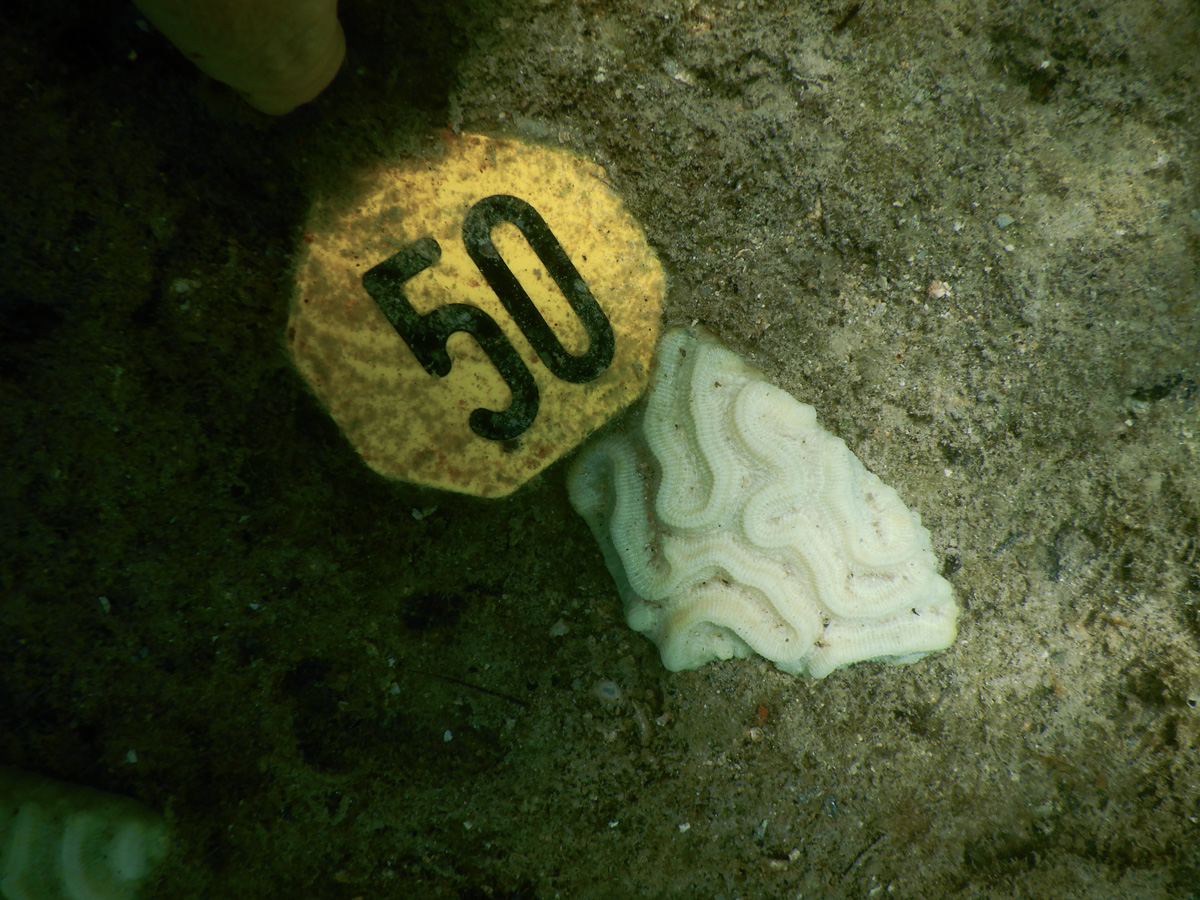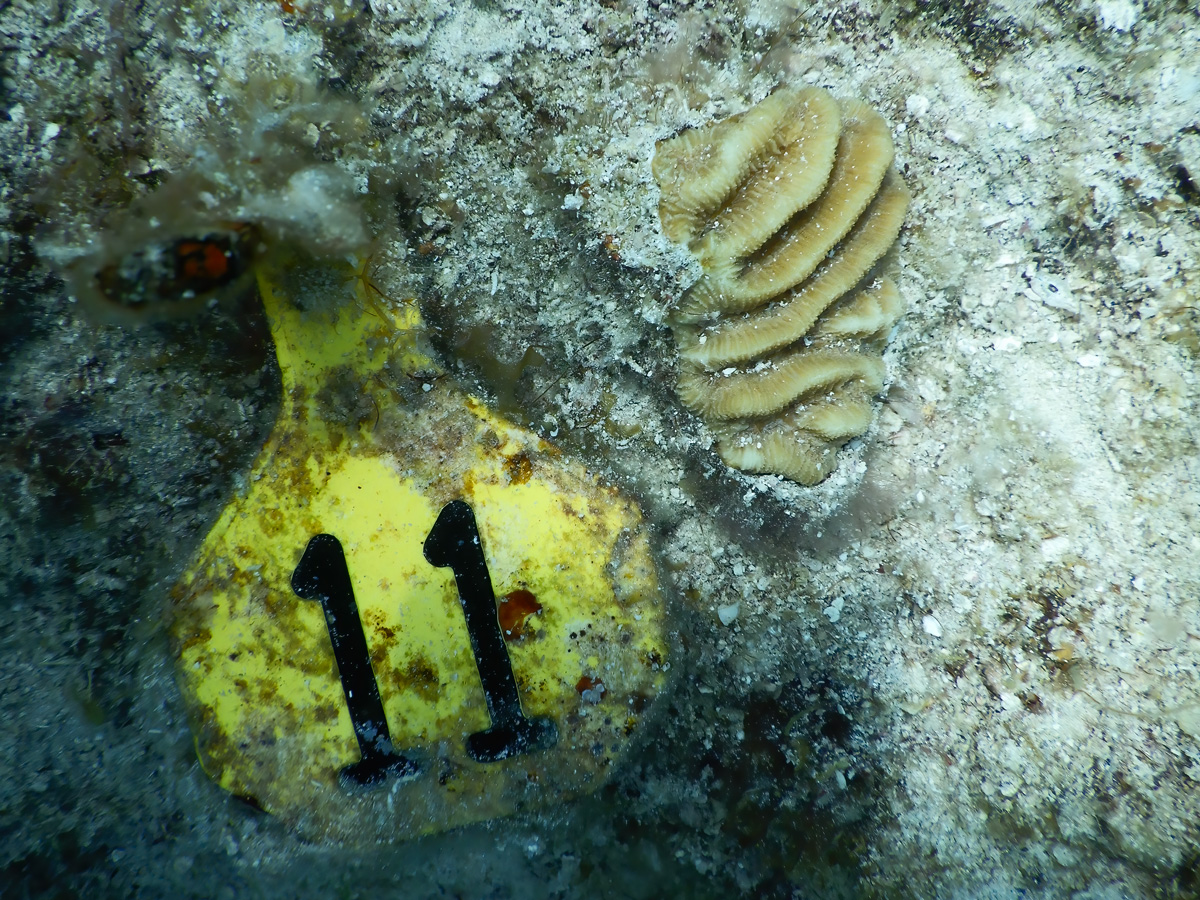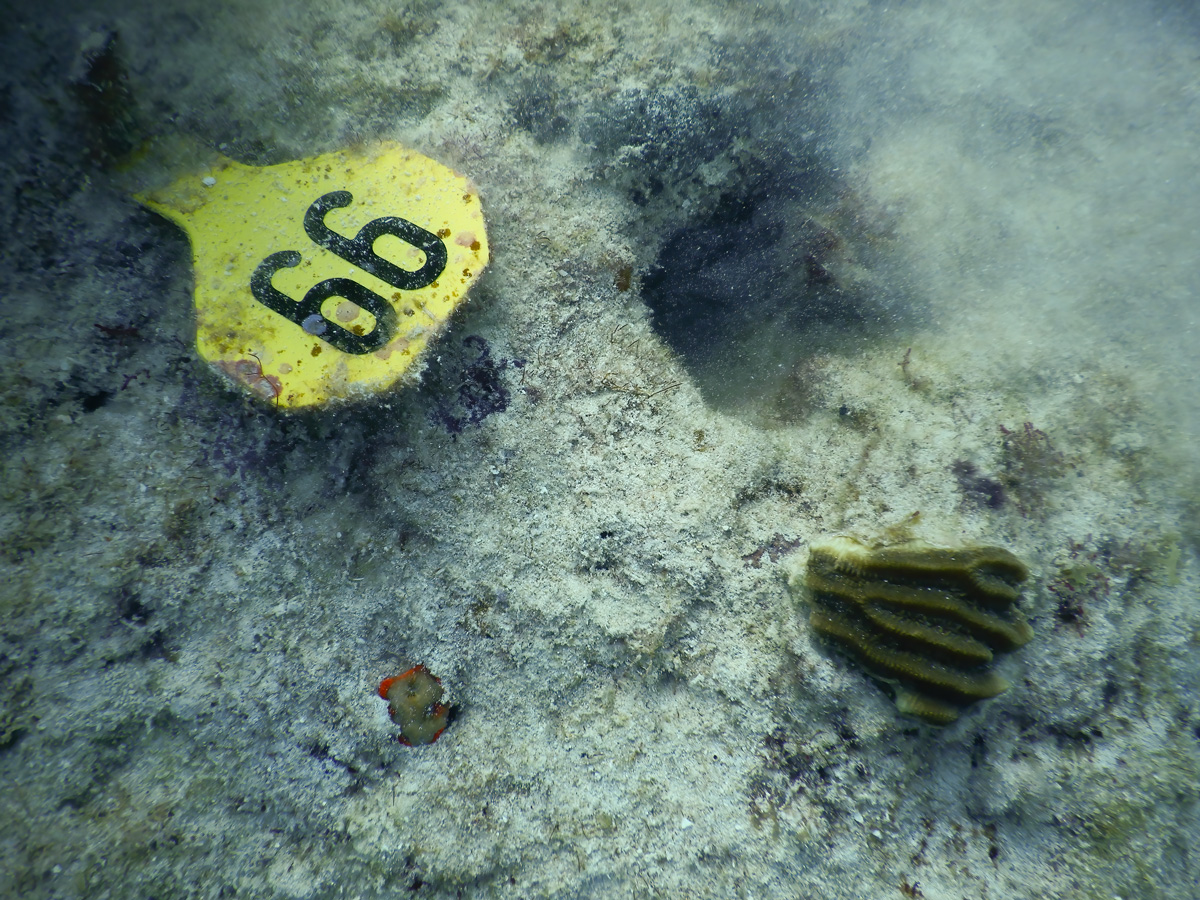Threats to Coral Reefs
Identifying and Addressing Threats to Reef Communities
JUMP TO MARINE HEAT WAVE
OR SCROLL TO LEARN MORE
What We Mean by "Threats"
Coral reefs face a variety of anthropogenic and environmental stressors from warming ocean temperatures and bleaching events to disease brought on by climate change and increased human activity, leading to degradation, loss of biodiversity, and a decline of the ecosystem benefits that reefs provide.
Before we can provide feasible and realistic solutions, we must first identify and address those stressors that most immediately impact coral reef communities from warming sea surface temperatures and bleaching events to disease. This page serves as a tool to keep you updated and informed regarding current threats to these natural ecosystems.

Elkhorn Coral (Acropora palmata) is an essential reef-building coral throughout the Caribbean, and it is currently critically endangered (IUCN Status) due to ocean warming.
Ocean Acidification
As oceans warm, they are able to take up and store greater concentrations of carbon dioxide (CO2) that has serious negative effect on reef ecosystems and other marine environments globally: Ocean Acidification (OA). Following the chemistry, an increase in CO2 taken up by the ocean leads to an increase in hydrogen ions (H+) in the ocean through a series of chemical reactions, making the oceans more acidic. This increase in hydrogen ions threatens coral reefs as they bind with carbonate, an essential molecule corals require to build their hard internal skeleton (composed of Calcium Carbonate, CaCO3). With less available carbonate ions, corals and other organisms including oysters and shellfish are unable to maintain and build up the hard structures they need to live.
The effects of ocean acidification on coral reefs are thus amplified by increased emissions of carbon into the atmosphere. Identifying how corals persist in response to this environmental stressor is crucial to understanding the future of coral reef ecosystems. AOML scientists continue to advance research including a new monitoring framework that will aid resiliency and restoration efforts.


Coral Bleaching
Coral bleaching occurs when corals become physically stressed due to extreme changes in temperature, light or nutrient concentrations in their surrounding habitat, and they expel the photosynthetic algae found within their tissue, turning them a pale white and leaving them vulnerable to mortality. However, bleaching does not mean the corals immediately die, and they can recover from a bleaching event.
This photosynthetic algae is both the major source of food for corals (producing organic carbohydrates that the coral needs to survive) and gives the coral its vibrant coloration, thus explaining why they turn a pale white when the algae is expelled. When bleaching occurs, corals cannot play host to their photosynthetic algae again until the physical stress (high sea surface temperatures, reduced light penetration of the marine ecosystem, etc.) is reduced, and the longer the physical stress persists, the more likely corals are to undergo mortality.
To see what bleaching looks like, click here.


Marine Heat Waves
A marine heat wave is when the ocean temperature is extremely warm relative to what is typically considered “normal,” or above the 90th percentile for at least 5 days – but some can last for months. The prolonged marine heat wave of 2023 in the Atlantic Ocean, Gulf of Mexico, and Caribbean Sea has the potential to have negative impacts on marine ecosystems, specifically the bleaching of corals. To learn more, see here.
Coral Diseases
Corals are highly susceptible to a variety of diseases that have increased in frequency over the last few decades. White band disease mainly threatens Acropora cervicornis (Staghorn) and Acropora palmata (Elkhorn), both ESA-listed species that are key to restoration efforts across Florida and the Caribbean. Of growing concern is the fast-spreading Stony Coral Tissue Loss Disease (SCTLD) that was first observed on Virginia Key in 2014 and has expanded across the Caribbean.
AOML’s Coral Program is at the forefront of a joint multi-agency effort that strives to address and monitor these diseases with ongoing research aimed at finding solutions that mitigate the effects of disease on essential reef ecosystems. To learn more about our research on coral disease, click here.


Dredging
Digging up of debris and resuspension of sediment from the bottom of marine environments during dredging operations is a key stressor to corals. Dredging is typically performed to widen or deepen navigation channels in bodies of water used for shipping and recreational boating. As vessels increase in size to carry greater loads, channels must be made deeper and wider.
How does this impact corals?
If not done carefully, dredging can stir up sediment and increase turbidity that attenuates the amount of light needed by photosynthetic symbionts living in the soft tissue of corals. Furthermore, high sedimentation rates can lead to coral mortality by burying colonies and decreasing the ability of coral larvae to settle and survive in the area impacted. When marine sediment becomes resuspended, it may also carry pathogenic bacteria that can trigger coral disease outbreaks.
What’s being done?
AOML Scientists are working in partnership with the Army Corps of Engineers (ACE) to develop the ‘Environmental Information Synthesizer for Expert Systems’ (EISES), a state-of-the-art water quality and turbidity monitoring system that will inform management of dredging activities in Port Everglades of Ft Lauderdale in Florida. The goal is to mitigate the effects of dredging on benthic ecosystems when expansion of the Port Everglades begins in 2027. Current testing and data collection prior to the onset of dredging operations is essential to establish baseline conditions of turbidity, water quality and other environmental parameters in the surrounding area to distinguish between disturbances caused by natural processes (e.g. high winds and strong current) and what is caused by dredging.
The EISES is installing multiple sensor packages to the seafloor and near the surface that transmit data in real time. Surface buoys also collect meteorological variables such as wind speed and direction, temperature, precipitation, and others.By combining these data sets the EISES will trigger early alerts when disturbances attributed to dredging are detected to inform management when dredging activities must be reduced or temporarily stopped to alleviate pressure on marine ecosystems.


Marine Heatwave Frequently Asked Questions
Marine heatwaves are anomalous warming events above the 90th percentile. In a practical sense, it means that they happen 10% of the time relative to long-term records, typically 30-year averages. Globally, they occur from 0 to 5 times per year, ranging from 5 to 40 days.
We monitor ocean surface temperatures from space and can see extremes develop in real time. Several factors may cause MHWs in the ocean, and these mechanisms influence the timescales of the predictions of these events. On top of all is global warming, which has already added more than 1 deg Celsius to the temperature above pre-industrial levels, It is projected to rise between 1.5 to 4C above pre-industrial levels by 2100.
Every marine heatwave is significant, by definition. Ocean temperatures in the Summer of 2023 (the most recent marine heatwave) were extremely warm relative to what we typically consider to be “normal”. Among historical marine heatwave conditions, the event of Summer 2023 was on the upper end of “average.”
The last time there was a marine heatwave of that magnitude that encompassed this much of the Gulf of Mexico was in 2020.

Water temperatures throughout the Gulf of Mexico and in the Caribbean Sea were anywhere from 1-2.5˚C (~2-4.5˚F) warmer than normal in July and early August of 2023. Temperature anomalies like this aren’t unprecedented, but they are concerning while in the thick of the Atlantic hurricane season (June – November) with the tropical North Atlantic already warm. Developing storms that pass into the region during a marine heatwave or with above average sea surface temperatures can be fueled by the warm waters as a result. Additionally, over time it will impact the different species of animals that call the ocean home.
The Gulf of Mexico marine heatwave began around November or December of 2022.
Our experimental marine heatwave forecasts indicate a 70-80% chance that extreme ocean temperatures will persist in the southern Gulf of Mexico and Caribbean through October 2023. That being said, our historical forecast skill in this region at 3.5 month leads is lower (though still better than random guessing).
Exposure to extreme temperature for long periods of time causes a breakdown in the relationship between coral and the algae that lives inside of them. The coral is left pale or white, i.e., bleached. The lack of food from the algae can lead to the death of the coral, subsequent erosion of the habitat, and ultimately a loss of the ecosystem services that we rely on including fishing and food, storm protection, tourism, and biodiversity. We are seeing instances of coral bleaching in the Miami area. Severe bleaching and significant mortality is also likely if the marine heatwave persists.
When corals are stressed by changes in conditions, such as extreme temperatures or reduced light penetration, they may expel the symbiotic algae living in their tissues, causing them to turn completely white in a process known as bleaching. Without the algae, they lose their major source of food and can become weak, potentially leading to death. However, if the conditions return to within optimal range for the corals (i.e. sea surface temperatures returning to average range), then the coral can become host again to the symbiotic algae and recover from the bleaching event.
To learn more about coral bleaching: https://oceanservice.noaa.gov/facts/coral_bleach.html
When a coral bleaches, it is not dead. Corals can survive a bleaching event if waters cool down and other sources of nutrition are available, but they are under more stress and ultimately susceptible to mortality. The rise in marine heatwaves can cause an unprecedented increase in coral mortality within coral reefs and damage ecosystem services. However, with the help of marine heat wave forecasting, we can anticipate the temperature rises and monitor coral reefs to learn more about their threats and how we can help support marine ecosystems.
To learn more about the marine heat wave forecast: https://psl.noaa.gov/marine-heatwaves/
For corals, the temperature is important but so is the amount of time that corals are stressed by the heat. The longer this stress persists, the more likely corals are to bleach. Bleaching does not always lead to death. But, again, if there is no relief from the heat, then corals don’t have time to recover from the stress, and they will eventually die. Corals are food and habitat for other marine organisms and if the corals die, this has a cascading effect on all the other life supported by the reef.
There are more isolated marine heatwave conditions off the Northeast US coast, along the Gulf Stream. We have also been monitoring a large marine heatwave in the Northeast Pacific (in the Gulf of Alaska) that has been sitting offshore for the past few months. There is some concern that it will spread along the US west coast as the current El Niño develops.
Bleaching Observations
(January 2023 – July 2023)
Below you will find examples of bleaching on experimentally outplanted corals at long-term monitoring and research sites by scientists with the AOML Coral Program, University of Miami, and the Cooperative Institute for Marine & Atmospheric Studies due to the marine heatwave of 2023.

MacArthur North
 July 11, 2023
July 11, 2023 January 26, 2023
January 26, 2023 July 11, 2023
July 11, 2023 January 26, 2023
January 26, 2023 July 11, 2023
July 11, 2023 January 26, 2023
January 26, 2023 July 11, 2023
July 11, 2023 January 26, 2023
January 26, 2023Emerald Reef
 July 11th, 2023
July 11th, 2023 January 26, 2023
January 26, 2023 July 11th, 2023
July 11th, 2023 January 26, 2023
January 26, 2023 July 11, 2023
July 11, 2023 January 26, 2023
January 26, 2023 July 11th, 2023
July 11th, 2023 January 26, 2023
January 26, 2023
